Hoya Caudata - How to Grow a Beautiful Flower
The bright and attractive Kawdata or Tailed Hoya, native to the rainforests of southern Thailand and Malaysia, was first described by explorer Hooker in 1883. Later, the flower was domesticated and successfully grown at home. Consider its characteristics and home care rules.
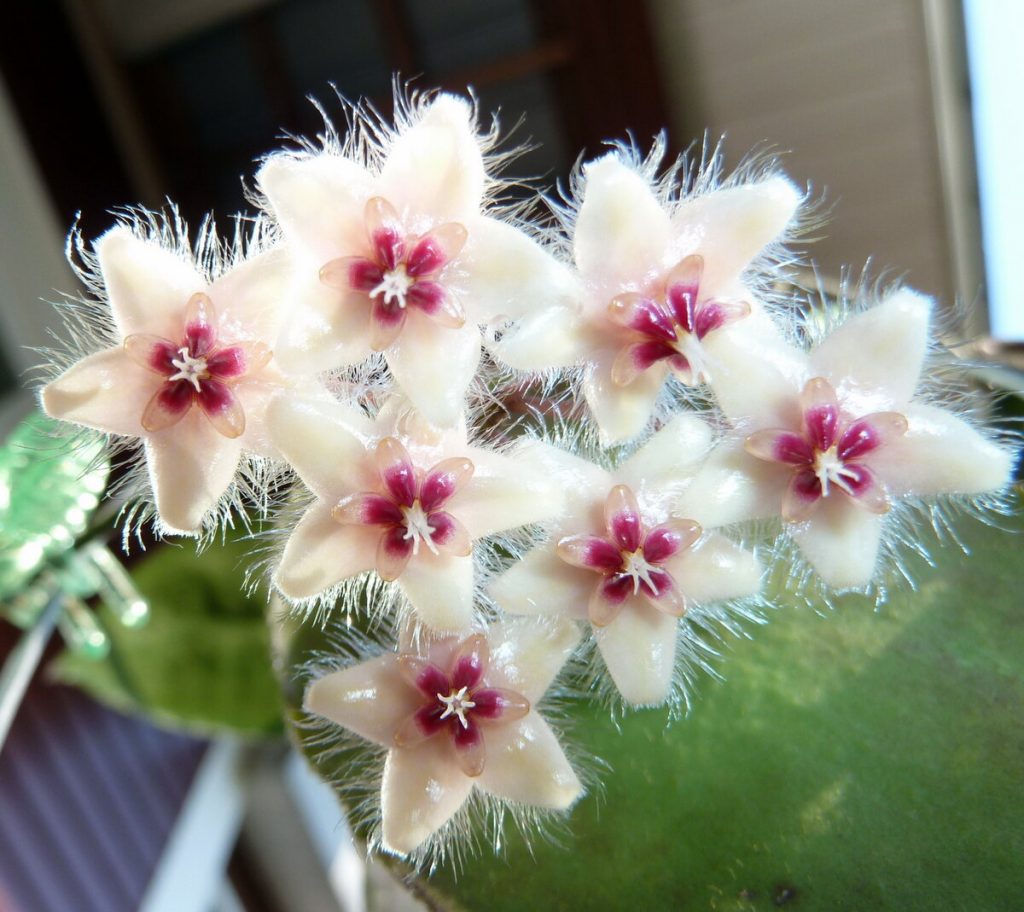
Hoya Caudata Big Green Leaves
Description of the plant
The botanical name is hoya caudata. This variety can be distinguished from others by several qualities:
- stems are long, curly, 0.3 cm in diameter;
- young shoots of a reddish tone with dense pubescence, adults acquire a rich green color with a slight pile;
- the leaves are located on thick cuttings, dense structure, rigid, ovoid or elongated, 9-14x4-6 cm in size;
- young leaves are soft with a waxy surface;
- from above, the leaf plate is covered with silvery specks, the underside is reddish;
- in the budding phase, the plant forms several flower stalks 3-4 cm long, small flowers bloom at the top of each, collected in flat inflorescences of 10 pieces;
- fleecy petals, pale pink color;
- in the middle there is a red crown with a white or burgundy center.
The life span of flowers is 7-8 days. During the flowering phase, hoya does not emit nectar and does not smell.
Popular decorative varieties of the Tailed Hoya: Sumatra; Silver (Silver); Big green leaves (Big green leaves); Splash; Red (red); Gold.
Purchase and adaptation
You can buy the Kaudata variety in one of the flower shops. Choose grown and flowering plants that show no health problems.
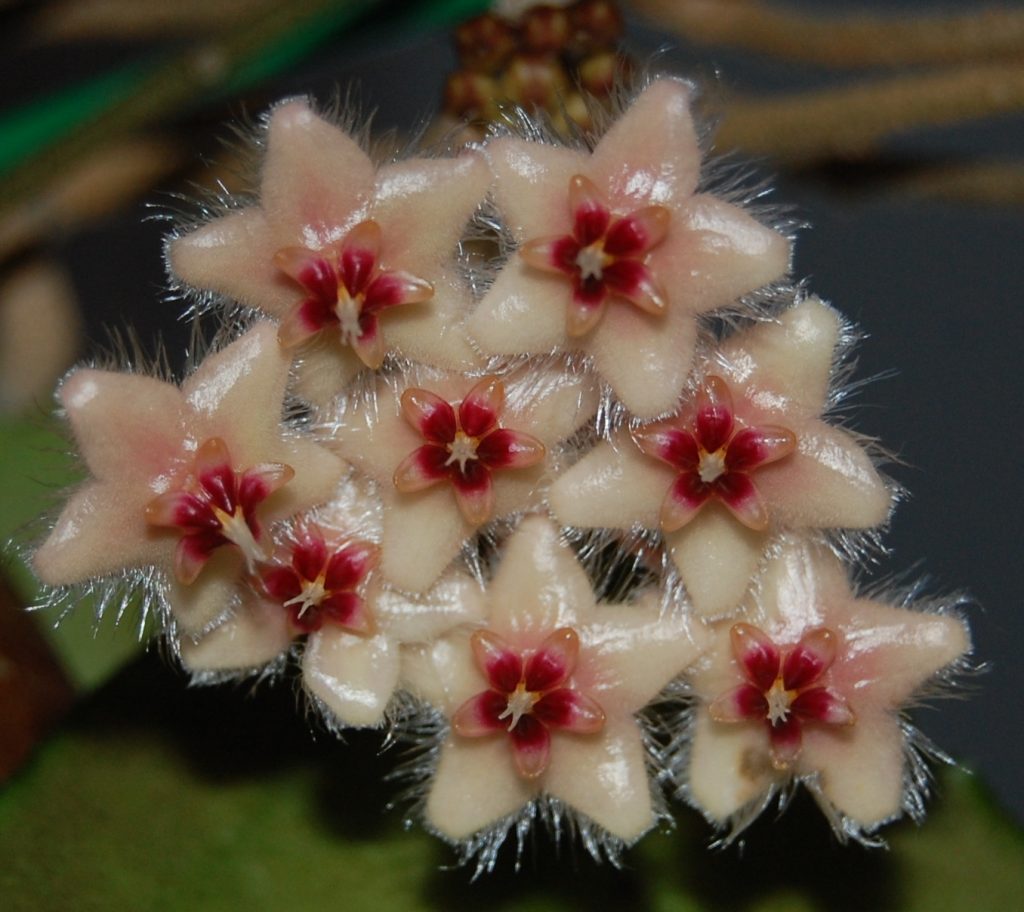
Hoya caudata
Their leaves and stems should be juicy, without defects - holes, cracks, outgrowths and blotches of an unnatural color.
After the purchase, the flower must be quarantined for 2-3 weeks. During this time, he will get used to the home growing conditions. You will also be able to determine if he has any diseases. If the hoya is healthy, after this time it is placed in a common room with other vegetation.
Landing rules
For cultivation, you will need a purchased substrate intended for planting decorative flowering plants. You can also take a mixture of turf, leafy soil, humus and sand (2: 2: 1: 1).
The best habitat will be a windowsill with good lighting in the morning and evening hours. Hoya can be placed on the southwest or east window.
Do not grow in the northern part of the house, since artificial lighting is required. When kept on a southern windowsill, shade is provided at lunchtime.
The necessary conditions
There are several vital conditions that need to be provided for this flower at home.
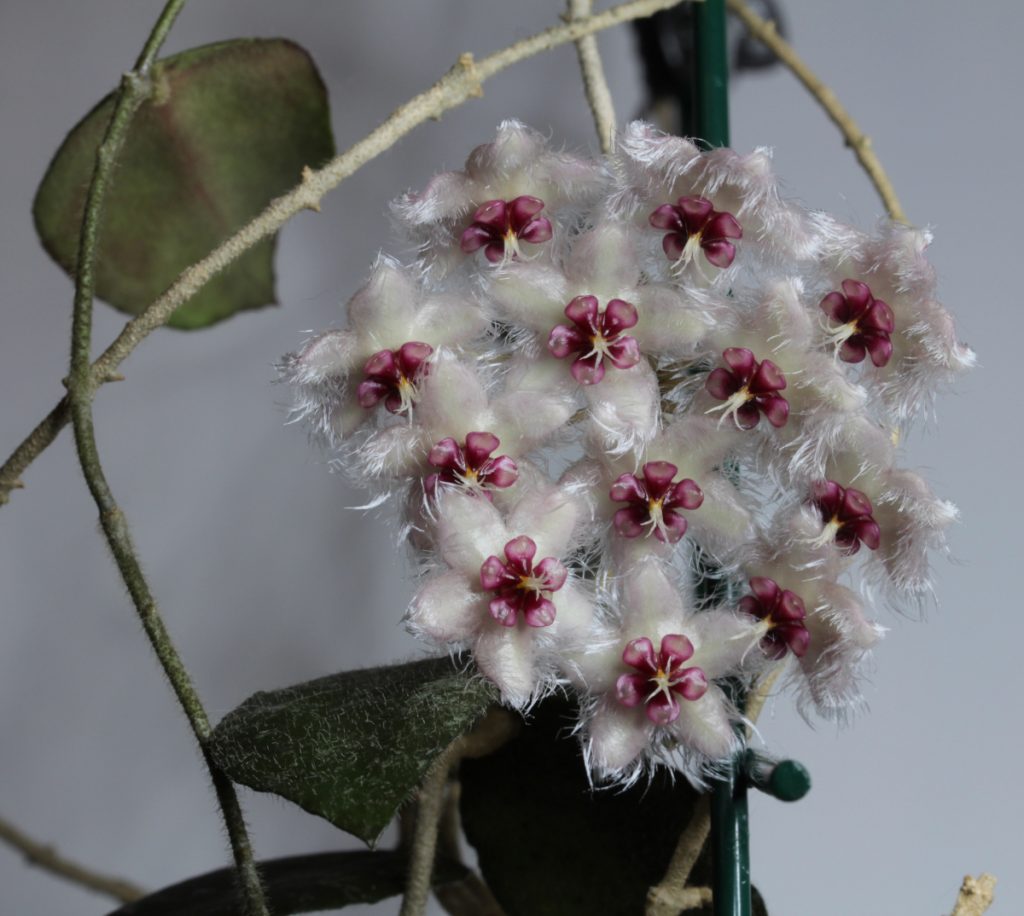
Hoya caudata sumatra
Humidity
The optimal indicator is 75-80%. During the growing season, the crown is irrigated every other day, in addition, an open container with water is placed next to it.
In winter, spray once a month to wash away dust and avoid parasites.
Temperature
In the warm season, they are kept at 22-28 ° C. In the resting phase in winter, it is lowered to 15-16 ° C.
Poorly tolerates sudden temperature changes, but loves fresh air. Therefore, the room must be regularly ventilated, having previously moved the flower to a place protected from a draft.
Lighting
Hoya Caudata loves a lot of light - it takes at least 10 hours a day. Protection from direct rays is important, otherwise the leaves will burn and dry out.
In spring and summer they are kept in a well-lit place, in winter they are supplemented with a fluorescent lamp.
Care features
All caring for an exotic flower at home comes down to several activities.
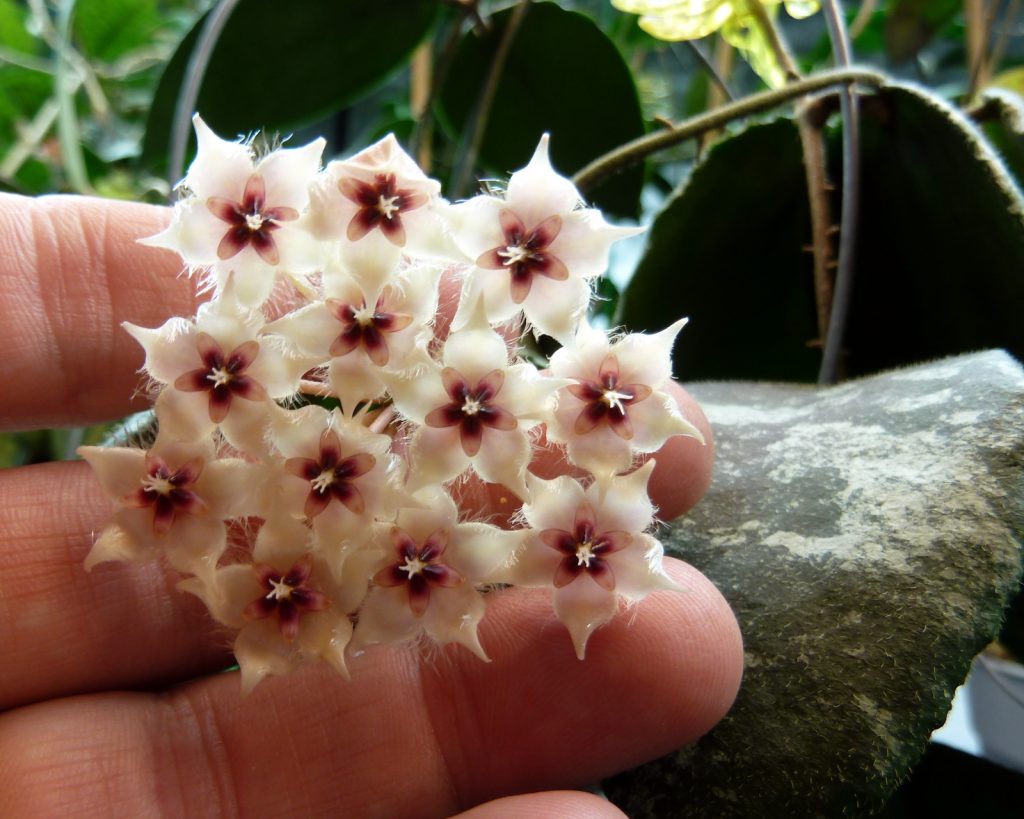
Hoya Caudata Silver
Watering
Moisturize abundantly, but not too often, since the plant does not tolerate excess moisture well. It is necessary to wait until the soil dries out to a depth of 3-4 cm.
In winter, the frequency of humidification is reduced to once a month. Poor watering stimulates high-quality and long-lasting flowering. After that, the soil is loosened to maintain its moisture and breathability.
Top dressing
Fertilization begins in early March, the last feeding is carried out at the end of August. Use ready-made mineral preparations, which include phosphorus, nitrogen and potassium.
First, top dressing is applied, then watered abundantly. Moisture helps the roots absorb nutrients faster.
Pruning
This plant is distinguished by intensive growth of shoots, therefore, the growth of lashes must be periodically restrained. Each spring, they are pruned to 15-20 cm in length. Additionally, twigs growing inside the crown or at the wrong angle are cut.
At the same time, a sanitary haircut is carried out - leaves and stems are removed.
After these manipulations, they irrigate with Epin's solution, which helps to bounce back faster.
Transfer
The purchased flower is transplanted after the end of quarantine, since the store substrate is not suitable for further cultivation. They take a flowerpot a little larger than the old one and always have drainage holes. A couple of handfuls of vermiculite or expanded clay are poured onto the bottom, then a small layer of fertile and loose soil. Hoya, together with an earthen lump, is transferred into a new pot, filled all the voids with earth, and watered.
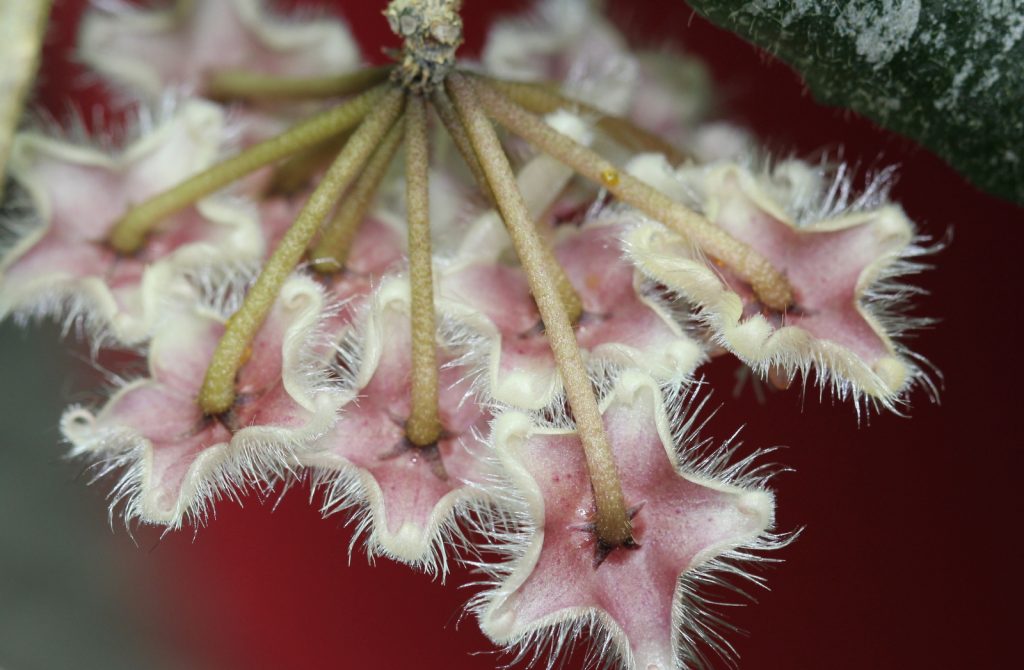
Hoya caudata ed
Basic care includes regular replanting of home flowers:
- young - after a year;
- adults every fourth year.
An unscheduled transplant is necessary for a hoya whose roots have rotted. It is removed, washed from the soil, cut out all the rotten parts, dipped in a fungicide solution for 2 hours, dried. After that, the flower is planted in a new pot with sterile soil mixture.
Reproduction methods
There are three options for getting new seedlings at home.
Cuttings
Shoots cut from the top of the stems with several leaves and buds, freed from the foliage in the lower part, dipped in Epin's solution for 30 minutes. After soaking, they are planted in a sand-peat mixture to a depth of 3-4 cm, and moistened.
For successful rooting, they are placed in a warm place with diffused light. After 2-3 weeks, they will release new leaves. After 2 months, they are transplanted into pots.
Sheet
Adult leaves with axillary buds are taken, dipped in Kornevin's solution, then planted in a wet mixture of peat and sand, covered with transparent glass. With regular ventilation and humidification, they will start to grow in 2 weeks. Then the shelter is removed, grown for another 1-2 years, until the stems are released, then they are seated separately.
Stem layering
They take the strongest and most flexible shoot, make an incision on it with a length of 1-1.5 cm. This place is wrapped with moistened moss, and covered with a transparent film on top. They wait for the roots to break through the moss. Remove the bandage, cut off the stem from the mother plant, plant it in a pot with a mixture of turf, leafy earth and sand (2: 2: 1).
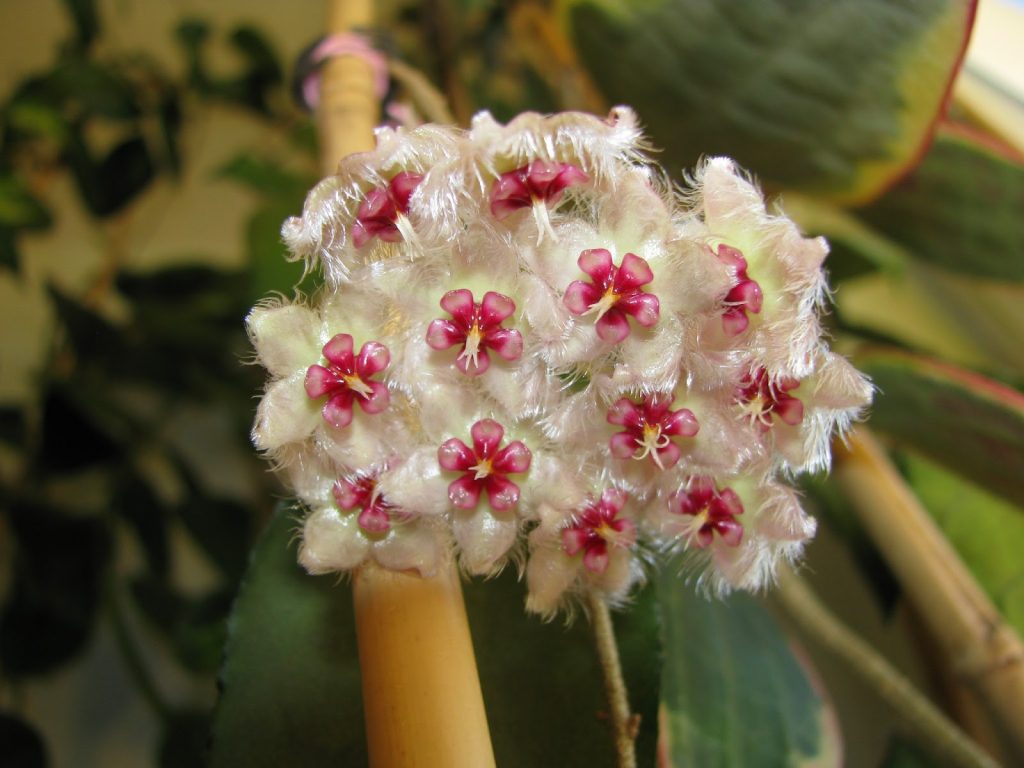
Hoya Caudata Silver Splash
Diseases and pests
Hoya has good resistance and rarely gets sick. Infection is possible if the rules of agricultural technology are violated.
| Diseases and pests | Diagnostics | Treatment | Prophylaxis |
| Aphids, scale insects, spider mites, mealybugs | Sucking insects feed on the sap of leaves, buds, and shoots. The damaged areas turn yellow, become covered with black or red spots, die off, dry and crumble | Cutting out dead parts, processing with Aktellik, Aktara, Fitoverm or Karbofos | Buying healthy flowers, keeping in quarantine, pruning non-viable areas on time. Compliance with watering norms, light and temperature conditions |
| Root rot | Appears due to frequent waterlogging. First, the roots rot, later the stems - in the lower part they acquire a black tone, become soft, slippery | The extracted roots are examined - if they have completely rotted, the hoya is thrown away, after cutting off the cuttings for rooting. With a slight infection, remove all rot, dipped in a fungicide solution for 2 hours. Dried, planted in a new pot with disinfected soil | Avoid overflow, use warm water for humidification |

